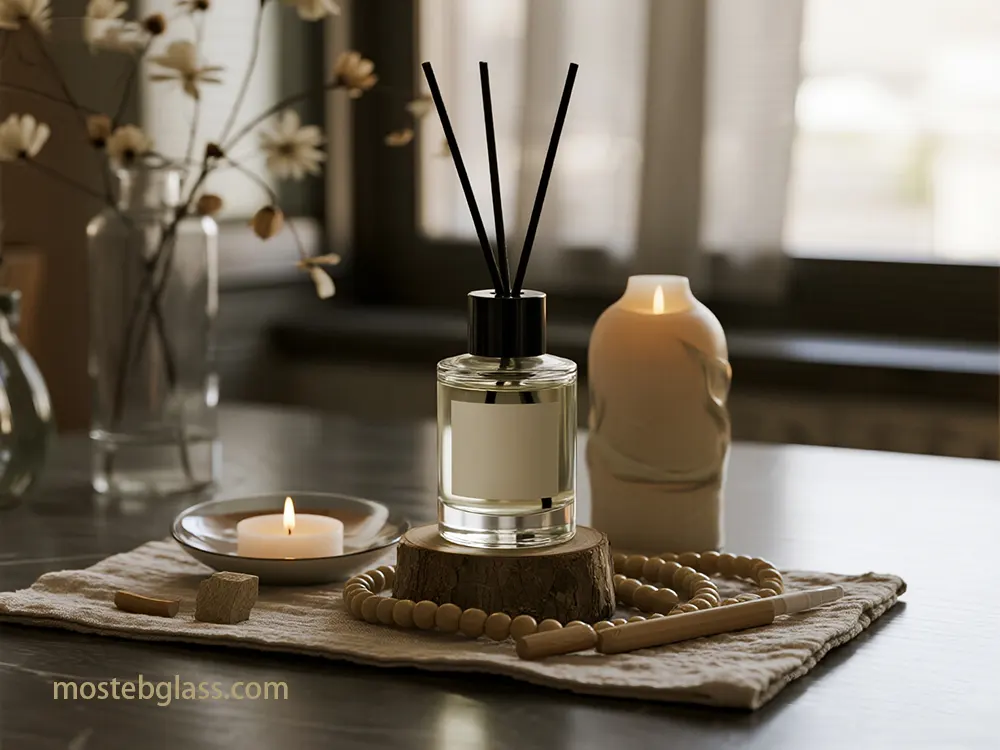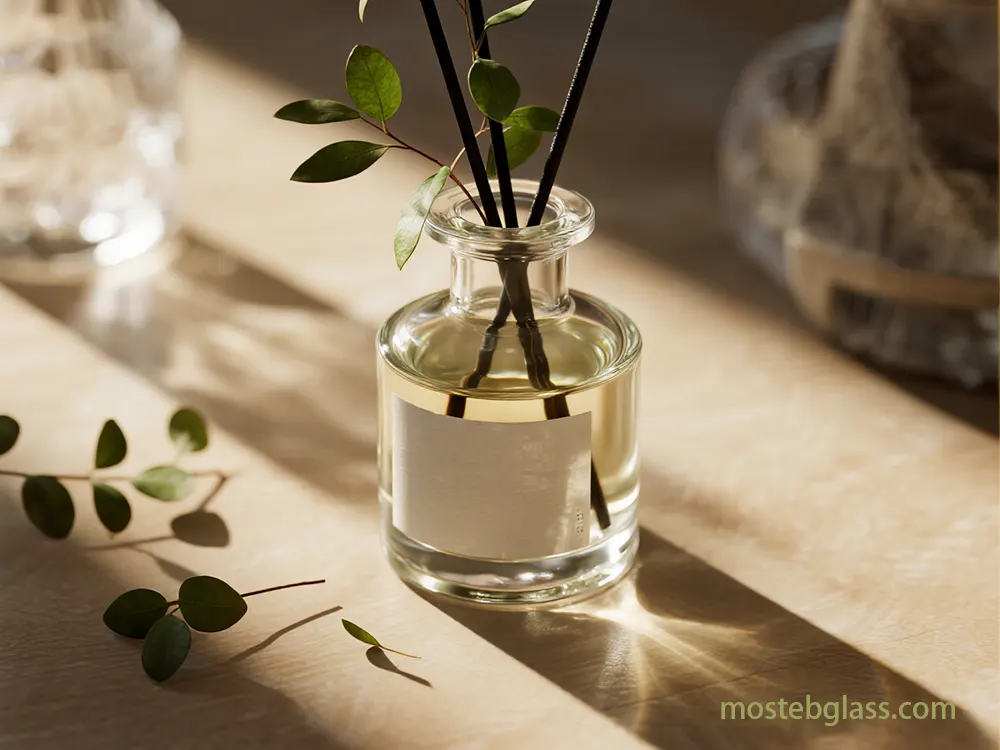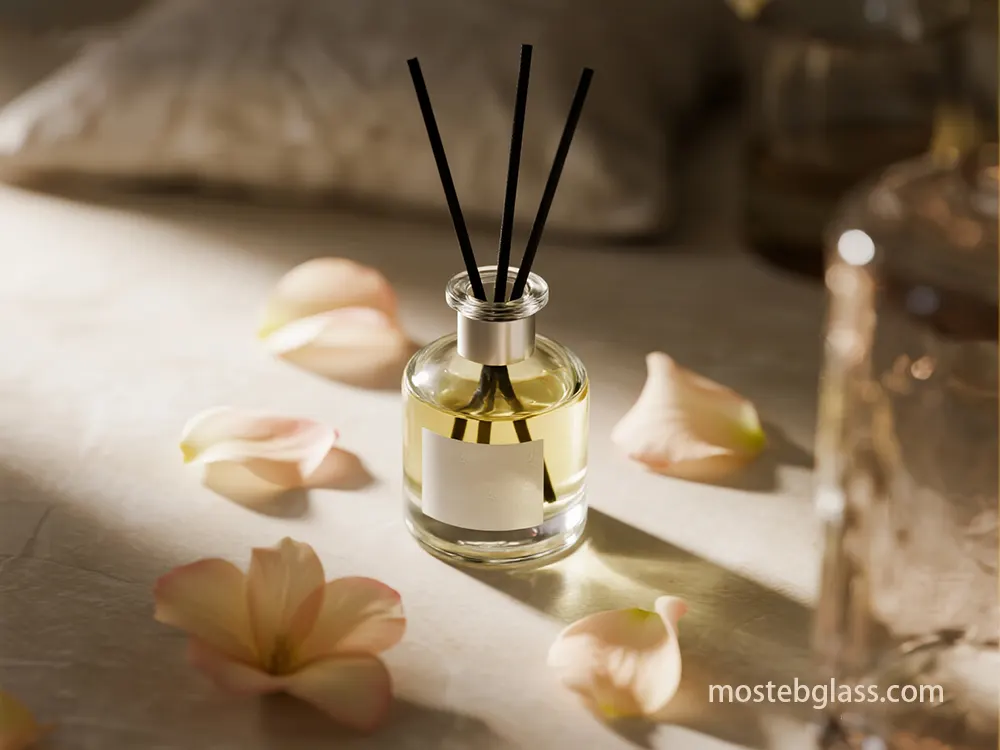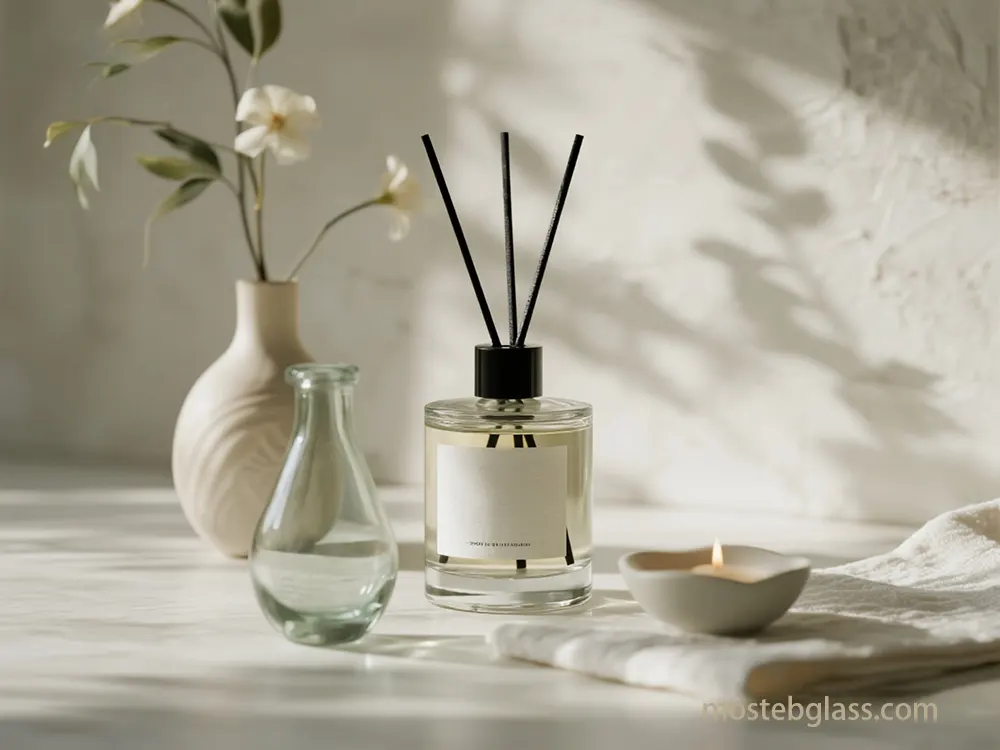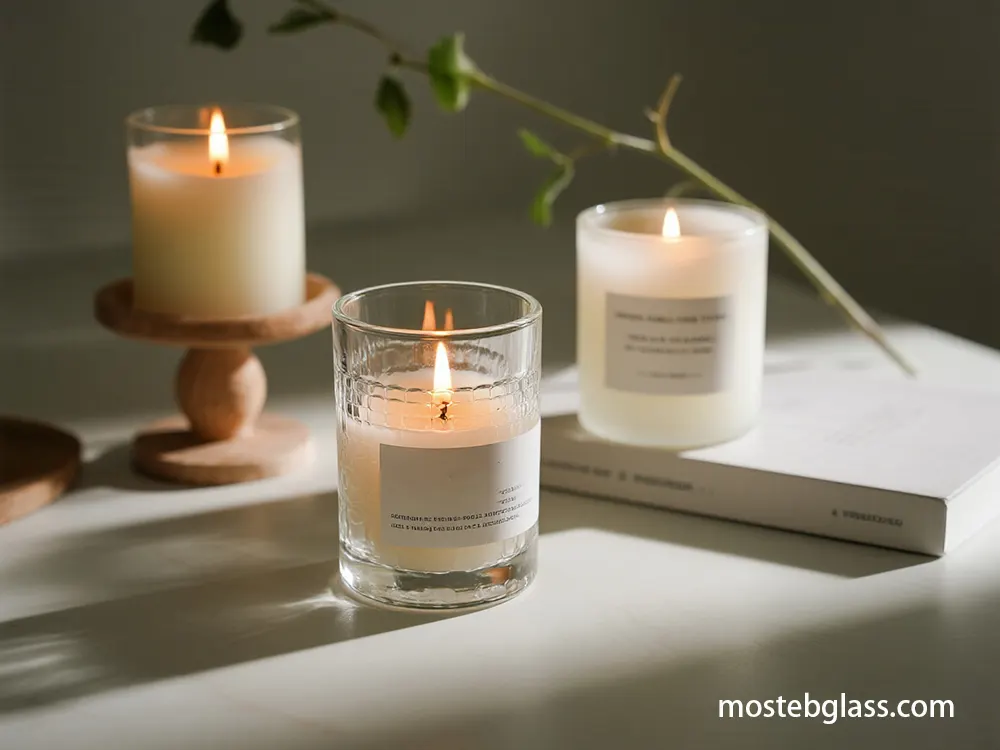1. Executive Summary
Luksussegmentet:
For den fornemme luksusmarked fremhæves prisfordele ved eksklusivitet, sjældenhed og den unikke historie bag hver omhyggeligt opgraderede del. Luksusproducenter bruger mere og mere kinosagtig fortælling til at kommunikere bæredygtighed. Mosteb skal vise den komplekse rejse for en krukke, der omdannes til et elegant, high-end produkt, fremhævende kunstfærdighed og miljøansvar.
Massemarkedet:
For det bredere massemarked kan fokus være på overkommelighed, tilgængelighed og praktisk anvendelse. Dette segment vil nås ved at fremhæve konkrete miljøforddele (affaldsreduktion, energibesparelser) og praktisk, daglig brug, hvilket gør bæredygtigt liv muligt.
3. Produktportefølje & Transformationsmetoder
Glas' mangfoldighed, især brugte candlekrukker, tillader en mangfoldig produktportefølje, fra minimal genanvendelse til kompleks materialeomdannelse, der dækker forskellige markedssegmenter. Metodikvalg afhænger af den ønskede slutprodukt, driftsskala og målgruppe.
- 3.1. Product Categories from Used Candle Jars Our product portfolio will encompass a comprehensive range of items, designed for different market segments and leveraging various transformation methodologies:
- New Candles: The most direct circular application involves cleaning and refilling jars with new wax and wicks. This closed-loop solution can be incentivized through refill programs, encouraging repeat business and waste reduction.Mosteb could offer a premium refill service, providing discounts for returned jars, fostering loyalty and responsibility.
- Home Decor Items: Vases and Planters:
- Jars transform into decorative vases or mini planters for succulents, herbs, or small plants.Varied dimensions create diverse aesthetic appeal. Lighting Fixtures:

Upcycled jars become unique lamps, lanterns, chandeliers, or wall sconces, from simple DIY to professional designs.Integrating energy-efficient solar or LED lighting enhances eco-appeal.
- Storage Solutions: Jars are naturally suited for diverse storage: kitchen pantry (spices, dry goods), bathroom accessories (cotton balls, brushes), or craft supplies (buttons, beads).Personalized pincushions/sewing kits can be crafted by adding fabric tops .
- Decorative Accents: Jars can be artistically decorated using painting (frosted, stained glass), etching, or embellishments like lace, beads, jute rope, or fabric wraps.Seasonal/holiday decor offers a distinct niche.
- Craft Materials (Crushed Glass): Sand Art:
- Crushed, polished glass can be used for intricate layered sand art. Terrazzo/Concrete Aggregates:
- Crushed glass serves as a sustainable, visually appealing aggregate in concrete or terrazzo, offering eco-friendly alternatives and unique sparkling finishes for flooring, countertops, or architectural elements.Relevant for B2B construction/interior design partnerships. Art & Jewelry:
Finer crushed, polished glass can be used by artisans for mosaics, resin art, or unique components in handcrafted jewelry.
Glass Powder/Foam Glass:
Advanced processing transforms glass into fine powder or lightweight foam glass for specialized industrial applications like insulation, composite fillers, or advanced ceramics.
3.2. Transformation Methodologies
- Methodologies vary based on end-product and operational scale, ensuring efficiency and quality. Direct Upcycling/Repurposing:
- Minimal alteration, focusing on cleaning and minor enhancements.
- Cleaning and Preparation: Thorough cleaning removes wax, soot, and labels. Methods include freezing, hot water baths, or electric/stovetop griddles for wax removal.Labels are removed with hot water, soap, or specialized solvents.
- Minor Modifications: Adding new lids, functional pumps (for soap dispensers), or decorative elements enhances appeal and utility.
- Material Transformation (Crushing and Polishing): Breaking down jars into cullet or fine sand, then potentially polishing and coloring.
- Glass Crushing Equipment: Small-Scale Artisanal:
- Compact, user-friendly crushers (e.g., LSM Engineering G5, AaquaTools GLS 2.0) efficiently convert bottles into sand-like material.Budget options start around $890.
- Industrial Scale: Robust hammer or vertical crushers process larger volumes, producing fine cullet or sand with adjustable particle size (0.5mm-20mm).Brands like Compactors Inc. and Gradeall offer solutions with throughput from 50 kg/hr to 5,000 kg/hr.
- Glass-to-Sand Machines: Specialized machines (e.g., Expleco Limited, Krysteline Technologies) convert glass directly into high-quality sand or finer powder/foam glass.
- Glass Polishing Equipment: Artisanal Polishing:
- Mini glass polishing machines, pads, abrasive belts, and diamond wheels achieve desired finishes for small-scale projects.GT Tools offers kits for removing blemishes. Industrial Polishing:
Advanced flat glass edging machines (e.g., Neptun, Battellino) provide precision grinding and surface polishing for high-volume production.Robotic polishing ensures consistency and precision for large-scale operations.
Coloring & Treating Crushed Glass:
- Inks and Dyes: India ink or translucent spray paints provide vibrant, lasting hues.Alcohol inks can be used, but may fade.
- Surface Treatments: “Rub and Buff” adds metallic/colored finishes to edged glass.Decoupage mixed with liquid food coloring coats containers for artistic effects.
- 3.3. Operational Considerations Safety Protocols:
- Handling glass calls for strict PPE: reduce-resistant gloves, protection glasses, lengthy sleeves, long lasting pants, closed-toe shoes, and hard hats, especially in crushing areas.Ongoing schooling in secure dealing with, dust manage (ventilation, moist slicing), and chemical safety is important. Maintenance:
- Regular, proactive upkeep of all crushing and polishing device guarantees longevity, most effective performance, and consistent pleasant. This includes daily exams, ordinary cleansing, and monthly inspections of components.
- Strategically combining these methodologies, Mosteb can create a diverse, appealing, high-quality product line, maximizing value from every used candle jar. 4. Supply Chain & Operational Scalability
- Establishing a robust, reliable, and scalable supply chain for used candle jars is critical for long-term success, involving efficient collection, logistics management, and appropriate operational scale. 4.1. Anticipated Sources and Volume of Used Candle Jars
- We envision a multi-pronged sourcing approach, ensuring consistent, high-quality, and sustainable supply: Direct Consumer Collection Programs:
- Incentive-Based Returns:
- Implementing attractive programs (e.g., similar to Slow Made, Yankee Candle/TerraCycle partnership) where consumers receive shop credits, discounts, or free products for returning clean, unbroken jars.This engages customers, fosters loyalty, and promotes circular consumption. Convenient Drop-off Locations:
- Establishing accessible drop-off points at our retail locations, partner stores (e.g., zero-waste shops), or community centers. Placing containers where glass is frequently purchased (liquor/grocery stores) can maximize collection. Mail-Back Programs:
- For wider geographical reach, a free shipping mail-back program could be explored, especially for high-value jars.
- Cleaning Requirements: Clear instructions for cleaning jars (e.g., freezing to remove wax, washing with soap/hot water) will be provided to minimize contamination.
- Partnerships with Candle Manufacturers: Post-Consumer Jar Recovery:
- Regular, proactive upkeep of all crushing and polishing device guarantees longevity, most effective performance, and consistent pleasant. This includes daily exams, ordinary cleansing, and monthly inspections of components.
Collaborating with manufacturers to recover their post-consumer jars returned through their programs or from their waste streams. This aligns with Extended Producer Responsibility (EPR) standards.
Co-Branding Opportunities: Exploring at the same time useful co-branding projects in which Mosteb upcycles jars from a companion producer, growing precise product strains highlighting shared sustainability commitments.
Waste Stream Diversion: Engaging with producers who’ve inner waste streams of imperfect, mislabeled, or unsold jars for upcycling.
Waste Management Streams:
Material Recovery Facilities (MRFs):
Partnering with local MRFs to source glass, focusing on suitable candle jar streams. This requires negotiation and quality control due to contamination challenges in single-stream recycling.
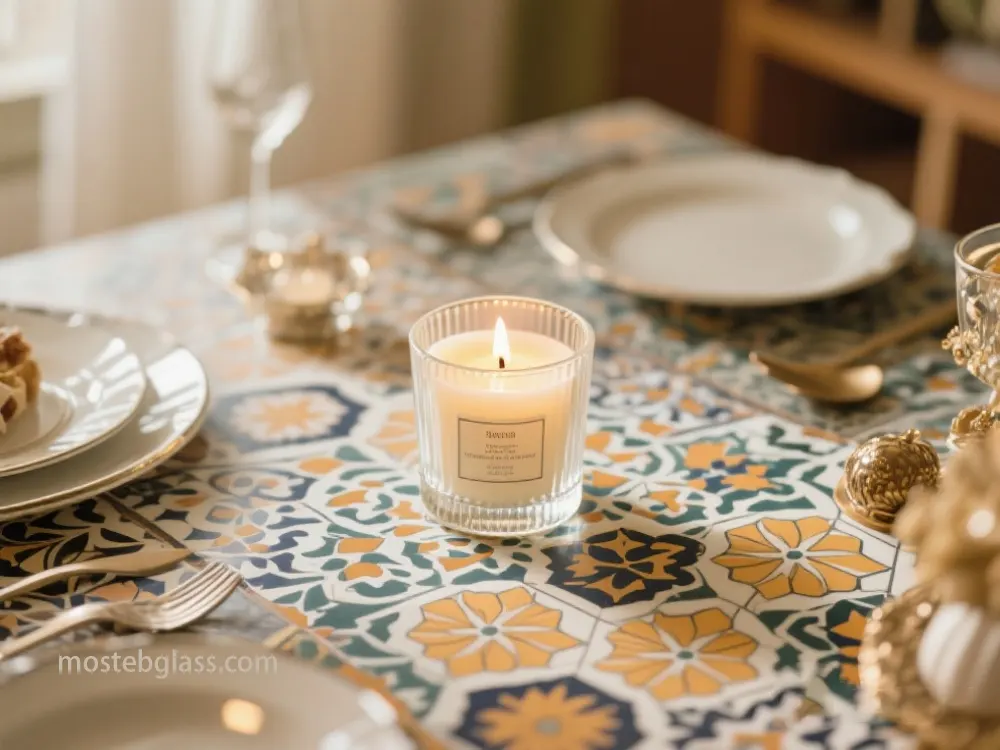
“Don’t Trash Glass” Programs:
Adapting successful initiatives like Diageo’s program for collecting glass from hospitality businesses could provide larger commercial volumes.
- Digital Waste Marketplaces:
- Utilizing platforms like Resourcify, Recykal, or LeeCycle to connect with waste generators, streamlining sourcing and potentially offering real-time trading for glass cullet.ASPIRE facilitates industrial symbiosis. 4.2. Operational Scalability
- Operational scalability will be a phased approach, moving from artisanal, small-batch production to industrial-scale operations as demand and supply grow. Small-Batch Artisanal (Initial Phase):
- Focus: High-value, unique home decor and new candles emphasizing bespoke craftsmanship, design, and storytelling.
- Collection: Primarily direct consumer returns and localized community partnerships.
- Processing:
- Investering i mere effektiv halvautomatisk rengøring/sortering, og større småskala-smidere til udvidede volimer. Mellemstor Ekspansion:
- Udvikling af produktlinjer, introduktion af flere standardiserede hjemprodukter, og udvikling af B2B-tilbud. Betydelig ekspansion, formalisering af partnerskaber med lokale virksomheder, mindre candelmagere og regionale afleveringsnetværk.
- Investering i mere effektiv halvautomatisk rengøring/sortering, og større småskala-smidere til øgede volimer. Stort Skala Industrielt Genanvendelse (Lang-Term Vision):
- Massiv produktion af genbrugte produkter, potentielt inklusiv højvolumen glasaggregeringer til byggeri, maksimering af miljøpåvirkning.
- Formelle, store volumen-aftaler med store candelmagere for post-consumer kar回收 og dyb integration med kommunevareforvaltning. Betydelig kapitalinvestering i fuldt automatiseret glasbehandling, herunder AI-drevet sortering (op til 70 flasker/min, 99.8% nøjagtighed), automatisk glasbrud og avancerede poleringslinjer. Kræver robust industrielt støvkontrol og sikkerhedsprotokoller.
- Fordele: Opnåelse af skalaøkonomi, markant reduktion af affald i deponier og maksimering af miljøøkonomisk påvirkning.
- 5. Finansielle Prognoser & Profitabilitetsveje Økonomisk bæredygtighed er baseret på omhyggelig analyse af pris-systemer, forskellige indtjeningstrækk og strategisk prissætning. Selvom genbrugte produkter kan være dyrere at tilbyde end dem fra urørt materiale pga. dybdegående rengøring, sortering og førsteklasses behandling, kan deres specifikke ratetilbud, bæredygtighedsnarrativ og voksende kundeforbrug presse store profitabilitet.
5.1. Omkostningsstrukturer
Indkøbsomkostninger:
- Selvom råmaterial (brugte krukker) er "gratis," incitamenter til forbrugerretur og logistisk transport fra indsamlingspunkter indebærer omkostninger, samt potentielle gebyrer for forudsorteret glas fra MRF'er eller producenter. Indkøb fra flere, spredte lokationer kan øge transportomkostningerne.
- Behandlingsomkostninger: Arbejdskrævende proces til at fjerne candelæs, røg og etiketter. Arbejde er en betydelig omkostningsdriver, især for direkte genbrug.
- Smidning og Polering: Initial kapitalinvestering i udstyr (f.eks. småskala-smidere $5.000-$20.000, industrielle pulverizer $20.000-$50.000). Ongoing driftsomkostninger inkluderer strøm (f.eks. ≤1.5 kWh/ton), vedligeholdelse og arbejde. Kvalitetskontrol:
- At sikre konsistens i genbrugte materialer er udfordrende pga. variationer. Dette kræver stramme, tilpassede kvalitetskontrolprocesser, hvilket tilføjer til produktionsomkostningerne. Produktionsomkostninger:
- Arbejde:
- Behandlingsomkostninger: Yderligere Materialer:
- Smidning og Polering: Initial kapitalinvestering i udstyr (f.eks. småskala-smidere $5.000-$20.000, industrielle pulverizer $20.000-$50.000). Ongoing driftsomkostninger inkluderer strøm (f.eks. ≤1.5 kWh/ton), vedligeholdelse og arbejde. Driftsomkostninger:
- At sikre konsistens i genbrugte materialer er udfordrende pga. variationer. Dette kræver stramme, tilpassede kvalitetskontrolprocesser, hvilket tilføjer til produktionsomkostningerne. Marketing- og Salgskostnader:
- Omkostninger til brandudvikling, digital marketing, deltagelse i markeds-/håndelsmesser og distributionsoptimering.
- Behandlingsomkostninger: Direct Product Sales:
- Smidning og Polering: Initial kapitalinvestering i udstyr (f.eks. småskala-smidere $5.000-$20.000, industrielle pulverizer $20.000-$50.000). Ongoing driftsomkostninger inkluderer strøm (f.eks. ≤1.5 kWh/ton), vedligeholdelse og arbejde. B2B Sales:
- At sikre konsistens i genbrugte materialer er udfordrende pga. variationer. Dette kræver stramme, tilpassede kvalitetskontrolprocesser, hvilket tilføjer til produktionsomkostningerne. White-Label/Custom Orders:
- Producing custom upcycled products for other manufacturers or clients searching for sustainable factors in their lines or advertising and marketing. Cullet/Glass Sand Sales:
Selling excess processed glass cullet or sand to different manufacturers (e.G., production aggregates, new glass production, abrasive blasting). While cullet prices are noticeably low ($10-$149/ton),this move offsets processing charges and contributes to a broader circular financial system.
Carbon Credits (Speculation):
Recycling glass notably reduces GHG emissions as compared to virgin glass production because of decrease electricity necessities.Companies could potentially earn carbon credits for verifiable emission reductions, supplying a unique destiny sales circulate.This calls for rigorous monitoring and 1/3-birthday celebration verification, potentially via structures like RecyclX.
- 5.3. Pricing Strategies & Profitability Pathways Profitability within the round economy for upcycled items is predicated on price-based totally pricing, aggressive positioning, and leveraging the sustainability narrative to command a top rate.
- Value-Based Pricing:
- Surface Treatments: Competitive Pricing:
While value-based, prices ought to stay aggressive within the broader upcycled/sustainable home items market. This might also contain strategically lower fees for mass-marketplace segments or highlighting accessibility. - Tiered Pricing: A tiered structure caters to diverse market segments: premium for unique handcrafted decor, mid-range for refilled candles, and accessible for basic functional storage.
- Surface Treatments: Competitive Pricing:
- Subscription Models/Leasing (Speculation):
- For refillable/reusable products, subscription or leasing programs could lower upfront costs for consumers while promoting extended use and waste reduction. Optimizing Cullet Composition:
- While 100% glass recycling is ideal, 25% cullet composition is often optimal for new glass production, balancing cost-effectiveness and environmental benefits.Selling excess cullet to other industries might be more profitable than 100% internal reuse if the external market is strong. Government Incentives and Grants:
- Securing grants, loans, and incentives for recycling, waste reduction, and circular economy initiatives significantly improves financial viability and accelerates growth.Programs like CalRecycle’s Recycled Glass Processing Incentive Grant Program offer substantial assistance. Circular Taxation Advocacy:
- Advocating for policy adjustments like decreased VAT on restore services, upcycled merchandise, or items extending product existence cycles ought to create a greater favorable monetary environment for circular businesses. Operational Efficiency via Automation:
While requiring better initial capital, strategic automation in cleaning, sorting, and crushing can drastically reduce long-time period labor costs, increase processing speed, and improve cullet exceptional.Crucial for massive-scale profitability.
- Strategic Partnerships: Collaborating with foremost candle producers for green jar recovery can notably reduce sourcing prices and create shared value.Partnerships with social firms can lead to price-effective hard work answers even as improving social impact.
- By handling costs, diversifying revenue, and adopting state-of-the-art pricing that highlights unique value and wonderful effect, Mosteb can establish a sustainable, worthwhile, and impactful challenge contributing meaningfully to the circular economy. 6. Environmental & Social Impact Assessment
- Transforming used candle jars aligns basically with round economy ideas, supplying great high-quality environmental and social impacts. Quantifying and transparently speaking these benefits is crucial for demonstrating fee to all stakeholders. 6.1. Environmental Impact Assessment
- A complete Life Cycle Assessment (LCA) will quantify environmental benefits of diverting used candle jars from landfills. Adhering to ISO 14040/44 standards, a “cradle-to-cradle” method will account for all product lifestyles cycle stages, emphasizing reuse and closed-loop recycling. Reduced Landfill Waste:
- Diverting hundreds of lots of non-biodegradable glass jars from landfills is a number one advantage, reducing land pollution and shielding assets. Energy Savings:

Recycling glass (cullet) consumes notably much less strength than generating new glass from virgin materials (sand, soda ash, limestone).Melting recycled glass calls for decrease furnace temperatures, saving 2-three% strength for each 10% cullet used,most important to decreased electricity consumption and GHG emissions
Reduced Raw Material Consumption:
- Using cullet at once reduces the want for extracting virgin raw substances. Every 1 kg of cullet replaces about 1.2 kg of virgin substances, retaining natural sources. Lower Carbon Emissions:
- Reduced strength intake immediately decreases CO2 emissions. CO2 emissions from virgin glass manufacturing (e.G., limestone decomposition) are prevented whilst the use of recycled glass. Water Usage Reduction:
- Incorporating cullet also measurably reduces water utilization. Key Impact Categories for LCA:
- Detailed LCA will check: Global Warming Potential (GWP) (kg CO2 equivalent),Energy Demand (primary and embodied strength),Air Emissions (SO2, CO2, NOx),and Eutrophication and Acidification. LCA Software and Data:
- Industry-wellknown gear like SimaPro, GaBi (Sphera), Ecochain Mobius, or openLCA might be used, gaining access to reliable databases (e.G., Ecoinvent) for correct analysis. Benchmarking:
- Comparative research will benchmark Mosteb’s upcycled merchandise towards similar virgin or other recycled fabric products, imparting clear proof of advanced environmental performance. Obtaining legit certifications like “Upcycled Certified”or “Global Recycled Standard (GRS)”affords 0.33-birthday celebration verification, enhances credibility, builds patron consider, and stops greenwashing.UPMADE® Certification could also be taken into consideration.
- 6.2. Social Impact Assessment Beyond environmental blessings, the initiative generates profound effective social affects. A Social Return on Investment (SROI) framework will systematically degree and account for those blessings, translating consequences into financial terms in which possible.
- Job Creation and Economic Empowerment: Upcycling creates diverse employment opportunities from series and sorting to crafting and advertising and marketing. This consists of direct jobs for nearby artisans, production workforce, and administrative roles, probably empowering marginalized groups.Recycling usually creates more jobs than landfilling, with reuse/upcycling creating even more.
- Skill Development and Knowledge Transfer: Structured workshops, training applications, and mentorship will foster talent-sharing and understanding switch, improving neighborhood craftsmanship, selling entrepreneurship, and building a professional circular economic system body of workers.
Community Engagement and Cohesion:
Accessible network series packages and lively resident involvement in workshops/layout will foster shared cause and obligation closer to waste reduction.This promotes social cohesion and builds a collective identity round sustainability.
Educational Opportunities:
The initiative serves as a dynamic instructional platform, raising awareness approximately circular economy principles, sustainable consumption, and waste cost.Educational outreach, probably with neighborhood colleges/environmental companies,empowers knowledgeable, sustainable choices.
Support for Local Economies:
- Prioritizing neighborhood sourcing and activity advent at once contributes to nearby monetary energy, retaining cash circulating in the community. Preservation of Craftsmanship:
- For artisanal products, the initiative preserves and promotes conventional craftsmanship by means of integrating those abilities into cutting-edge upcycling. SROI Measurement:
- The sturdy SROI framework will systematically: Establish Scope (define assessment limitations/goals); Map Outcomes (pick out nice changes like jobs created, waste diverted, workshop members); Demonstrate and Value Outcomes (assign financial values wherein viable, e.G., economic value of reduced healthcare prices, expanded artisan profits, instructional attainment cost);Establish Impact (determine internet impact by using accounting for deadweight, attribution, displacement, drop-off); Calculate SROI Ratio (divide overall social/environmental cost via economic funding price; Ratio > 1 shows wonderful go back);Report Findings (transparently communicate SROI results to stakeholders, improving accept as true with, attracting funding, fostering partnerships). By fastidiously assessing, quantifying, and transparently speaking its environmental and social affects, Mosteb will demonstrate its commitment to sustainability and build a compelling case for its price as a responsible, modern, and impactful agency.
- How to Clean Wax Out of Candle Jar for Bulk Reuse Reducetil strength indtagt øjeblikkeligt CO2-udledninger. CO2-udledninger fra fremstilling af ren glas (f.eks. nedbrydning af kalksten) forhindres, mens genanvendt glas anvendes.
- Reduktion af vandforbrug: At indføre skraldglas målbart reducerer vandforbruget.
- Nøgleimpactkategorier for LCA: Det detaljerede LCA vil undersøge: Global Warming Potential (GWP) (kg CO2 ekvivalent),Energiforbrug (primær og indbygget styrke),Luftudledninger (SO2, CO2, NOx),og Eutrofiering og Søgningskemi.
- LCA Software og Data: Brug af velkendte værktøjer inden for industri som SimaPro, GaBi (Sphera), Ecochain Mobius eller openLCA kan foretages, med adgang til pålidelige databaser (f.eks. Ecoinvent) for korrekt analyse.
- Benchmarking: Sammenlignende forskning vil benchmark Mosteb’s opgraderede varer mod lignende rene eller andre genanvendte tekstilprodukter, hvilket giver klart bevis på forbedret miljømæssig performance.
- Certifikationer: At opnå legitimerede certifikater som “Upcycled Certified” eller “Global Recycled Standard (GRS)” giver 0.33-bådsfest verificering, forbedrer troværdighed, opbygger kunde tillid og forhindrer grøn omhyggeløshed.UPMADE® Certifikat kan også overvejes.
6.2. Social Impact Assessment
Ud over miljøfordeler genererer initiativet dybe positive sociale effekter. Et Social Return on Investment (SROI) rammeværk vil systematisk måle og tage højde for disse fordele, hvilket oversætter resultater til pengeværdi hvor muligt.
- Jobskabelse og økonomisk empowerment: Opgradering skaber forskellige beskæftigelsesmuligheder fra indsamling og sortering til håndværk og markedsføring. Dette inkluderer direkte jobs for lokale håndværkere, produktionsarbejdskraft og administrative roller, hvilket sandsynligvis kan empowerment marginaliserede grupper.Recycling skaber ofte flere jobs end afhængighed af deponering, og genbrug/opgradering skaber endnu flere.
- Færdighedskompetenceudvikling og Videnstransfer: Strukturerede workshops, uddannelsesprogrammer og mentorvirkemøder vil fremme færdighedsdeling og videnstransfer, hvilket forbedrer lokal håndværkskompetence, fremmer entreprenørskab og bygger en professionel cirkulær økonomisk arbejdsstyrke.
- Lokalsamfund engagement og Cohesion: Tilgængelige lokalsamfunds programmer og aktivt medborgerdeltagelse i workshops/planlægning vil fremme fælles formål og ansvar mod affaldsreduktion.Dette fremmer social Cohesion og bygger en fælles identitet omkring bæredygtighed.
- Uddannelsesmuligheder: Initiativet fungerer som et dynamisk uddannelsesplatform, der øger bevidsthed om cirkulære økonomiprinципы, bæredygtig forbrug og affaldsværdi.Education outreach, sandsynligvis med lokale skoler/miljøorganisationer, giver kundskaber til informerede, bæredygtige valg.
- Støtte til lokale økonomier: At prioritere lokal indkøb og aktivitetsskabelse bidrager direkte til lokal økonomisk styrke, hvilket holder penge i lokalsamfundet.
- Bevaring af håndværkskompetence: For håndværksprodukter bevarer initiativet og fremmer traditionelt håndværk ved at integrere disse færdigheder i moderne opgradering.
- SROI Måling: Det robuste SROI rammeværk vil systematisk: Etablere Omfang (definere evalueringens grænser/mål); Kortlægge Resultater (identificere positive ændringer som skabte jobs, flyttet affald, workshopdeltagere); Bevise og Vurde Resultater (tildele monetære værdier hvor muligt, f.eks. økonomisk værdi af reducerede sundhedsomkostninger, øget håndværksindkomst, uddannelsesværdi);Etablere Impact (bestemme netto impact ved at tage højde for deadweight, attribution, displacement, drop-off); Beregne SROI Ratio (dele den samlede sociale/miljømæssige omkostning med den økonomiske investeringsværdi; Ratio > 1 viser positiv afkast); Rapportere Fund (åbent kommunikere SROI resultater til interessenter, hvilket forbedrer tillid, tiltrækker investeringer, fremmer partnerskaber).
Ved at omhyggeligt vurdere, kvantificere og åbent kommunikere dets miljømæssige og sociale effekter, vil Mosteb vise sin engagement for bæredygtighed og bygge en overbevisende sag for sin værdi som en ansvarlig, moderne og impactful virksomhed.




